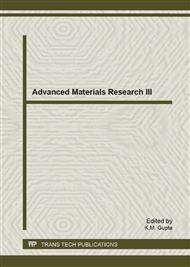[1]
Ezugwu, E.O., 2005, Key improvements in the machining of difficult-to-cut aerospace superalloys, International Journal of Machine Tools & Manufacture.45; 1353–1367.
DOI: 10.1016/j.ijmachtools.2005.02.003
Google Scholar
[2]
Ezugwu, E. O., Wanga Z. M., Machadop, A. R., 1998 ,The machinabilityof nickel – based alloys: a review, Journal of Material Processing Technology, 86 (1-3); 1 – 16.
Google Scholar
[3]
G. Weiping, X. Honglu, L. Jun and, Y. Zhufeng, "Effects of drilling process on fatigue life of open holes," Tsinghua Science and Technology, vol. 14, pp.54-57, (2009)
Google Scholar
[4]
Nabhani, F., 2001, Machining of aerospace titanium alloys, Robotics and Computer Integrated Manufacturing, 77; 99-106.
DOI: 10.1016/s0736-5845(00)00042-9
Google Scholar
[5]
Ginting, A., Nouari, M., 2006, Experimental and numerical studies on the performance of alloyed carbide tool in dry milling of aerospace material, International Journal of Machine Tools & Manufacture.46; 758–768.
DOI: 10.1016/j.ijmachtools.2005.07.035
Google Scholar
[6]
Zoya, Z.A., Krishnamurthy, R., 2000, The performance of CBN tools in the machining of titanium alloys, Journal of Materials Processing Technology. 100; 80–86.
DOI: 10.1016/s0924-0136(99)00464-1
Google Scholar
[7]
Ozel, T., Sima, M., Srivastava, A.K., Kaftanoglu, B., 2010, Investigations on the effects of multi-layered coated inserts in machining Ti–6Al–4V alloy with experiments and finite element simulations, CIRP Annals - Manufacturing Technology. 59: 77-82.
DOI: 10.1016/j.cirp.2010.03.055
Google Scholar
[8]
Venugopal, K.A., Paul, S., Chattopadhyay, A.B., 2007, Tool wear in cryogenic turning of Ti-6Al-4V alloy, Cryogenics, 47; 12-18.
DOI: 10.1016/j.cryogenics.2006.08.011
Google Scholar
[9]
Venugopal, K.A., Paul, S., Chattopadhyay, A.B., 2007, Growth of tool wear in turning of Ti-6Al-4V alloy under cryogenic cooling, Wear, 262; 1071-1078.
DOI: 10.1016/j.wear.2006.11.010
Google Scholar
[10]
Su, Y., He, N., Li, L., Li, X.L., 2006, An experimental investigation of effects of cooling/lubrication conditions on tool wear in high-speed end milling of Ti-6Al-4V, Wear , 261; 760-766.
DOI: 10.1016/j.wear.2006.01.013
Google Scholar
[11]
Yildiz, Y., Nalbant, M., 2008, A review of cryogenic cooling in machining processes, International Journal of Machine Tools & Manufacture, 48; 947–964.
DOI: 10.1016/j.ijmachtools.2008.01.008
Google Scholar
[12]
Sun, S., Brandt, M., Dargusch, M.S., 2010, Machining Ti–6Al–4V alloy with cryogenic compressed air cooling, International Journal of Machine Tools & Manufacture, 50; 933–942.
DOI: 10.1016/j.ijmachtools.2010.08.003
Google Scholar
[13]
Bermingham M.J., Kirsch, J., Sun, S., Palanisamy, S., Dargusch, M.S., 2011, New observations on tool life, cutting forces and chip morphology in cryogenic machining Ti-6Al-4V, International Journal of Machine Tools & Manufacture, 51; 500–511.
DOI: 10.1016/j.ijmachtools.2011.02.009
Google Scholar
[14]
Shaw, M. C., Metal Cutting Principles, 2nd edition, Oxford University Press, 2005.
Google Scholar
[15]
Abukhshim, N. A., Mativenga, P.T., and Sheikh, M. A., Heat generation and temperature prediction in metal cutting: A review and implications for high speed machining, International Journal of Machine Tools & Manufacture, 46; 782–800.
DOI: 10.1016/j.ijmachtools.2005.07.024
Google Scholar
[16]
Willaiams, J. A., and Tabor, D., 1977 ,The role of lubricants in machining, Wear, 43; 275 – 292.
Google Scholar
[17]
Trigger, K. J. and Chao, B.T., "Mechanism of crater wear of cemented carbide tools," Transactions of ASME, Vol. 78, No. 5, 1956.
DOI: 10.1115/1.4013949
Google Scholar
[18]
Jawaid, A., Che-Haron, C.H. and Abdullah, A., "Tool wear characteristics in turning of Titanium Alloy Ti - 6246," Journal of Materials Processing Technology, Vol. 92-93, pp.329-334, 1999.
DOI: 10.1016/s0924-0136(99)00246-0
Google Scholar
[19]
Corduan, N., Himbart, T., Poulachon, G., Dessoly, M., Lambertin, M., Vigneau, J. and Payoux, B., " Wear Mechanisms of New Tool Materials for Ti-6AI-4V High Performance Machining," CIRP Annals - Manufacturing Technology, Vol. 52, Issue 1, pp.73-76, 2003.
DOI: 10.1016/s0007-8506(07)60534-4
Google Scholar
[20]
Seah, K. H. W., Li, X., and Lee, K. S., "The effect of applying coolant on tool wear in metal machining," Journal of Material Processing and Technology, Vol 48, pp.495-501, 1995.
DOI: 10.1016/0924-0136(94)01688-w
Google Scholar


